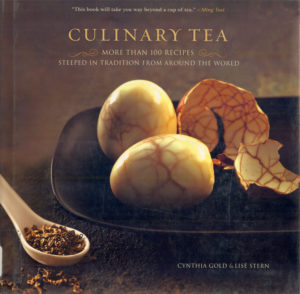
Culinary Tea More Than 150 Recipes Steeped in Tea from Around the World. Cynthia Gold and Lisë Stern. Published by Running Press, Philadelphia and London, 2010.
If you’re looking for a holiday treat, consider this tea cookbook and its recipes, Culinary Tea by Cynthia Gold and Lisë Stern. For instance I was surprised to find that a tea-infused recipe would lend such flair to a dessert made from milk. Actually I used almond milk, rather than whole milk, and when I tried “Green Tea Phirni with Diced Mangoes”, the Jasmine Tea infused in the almond milk and rice mixture, transformed the expected flavor from rather bland and sugary to exceptionally herbed, sweet without cloying, a sophisticated rice pudding. The resulting phirni took on a light cocoa color and very smooth texture.
Planning a holiday bash could be even more fun if you strike a new note with tea in your favor. So carefully explained in Culinary Tea are the kinds of flavors available with types of teas. Consider the importance of the temperature of water or other liquids to bring out the exact nature of a certain tea for your dishes. One thing you should be prepared for is tea holds no affinity for kinds of food it favors, and yet some teas are better suited to some foods than others. The key may be in the range of tea types, from white to black teas, also cover the range of what we think is fermentation, but is actually oxidization, from none to fully oxidized.
A vegetarian entrée comes alive with layers of flavors by adding tea, so you create subtle or brazen character for soups, sauces, condiments, appetizers, and more. Breeze past these introductory recipes and kick up a culinary storm with confections, cookies, cakes and pastries, custards, fruits, ice creams or sorbets. These tea-infused dishes are so special because they’re conceived by a tea sommelier whose knowledge of the beverage extends to use of it as a spice, along with a companion writer who shares her enthusiasm for tea drinking and eating.
Jasmine tea, a scented tea of complex flavors, can also reveal her top note as the flower, above the tea itself, if used to flavor another fat, such as olive oil. I discovered this by following the recipe for “Laphet Thote”, a Burmese salad made from tea leaves, in which tea leaves are marinated in the oil with garlic, chili and lime juice. Wow!
The authors reveal that the tea recipes came from several sources including chefs whose love of tea is cultural, and inspired chefs whose manipulation of flavors is an art form. But it’s really a time-honored art form: consider smoked duck, tea-smoked eggs, green tea ice cream, iced tea with raspberry syrup, and familiar dressings and appetizers with a welcome added dimension in taste.
Their Darjeeling Tea Vinaigrette infuses the tea in warmed-to-boiling vinegar (temperature depends on the type of tea you’ve chosen), then honey, shallots, garlic, herbs, and salt and pepper complement the tea and this is mixed with oil and can be kept in the refrigerator for about one week. Another dressing that’s caught my imagination is Earl Grey Dried Cherry Mustard! With only the tea, sour cherries, and mustard this sauce is easy to prepare.
Darjeeling is a character, or as Gold and Stern call “style”, of black tea, so named due to the location in India where it’s grown. It’s got a reputation for a clean and clear taste and marries well with certain foods and the addition of flowers. Culinary Tea’s recipes using Darjeeling include Chocolate Bark, Beurre Blanc, Mung Beans, Lavender cookies, Pear Sangria, Roasted Sweet Potatoes, the Tea Vinaigrette described above, and an assortment of meat dishes—chicken and pork, and salmon.
Lapsang Souchong is also a character, or style of black tea that has been smoked with pine needles to yield a strong, smoky taste. Recipes that feature Lapsang include Mexican Black Bean Soup, Peaches and Cream Shortcakes, Smoky Black Lentils, Smoky Tea-Spiced Pecans, and Tea and Parsnip Soup, besides the leg of lamb, short ribs and marbled eggs dishes for omnivorous diets.
Earl Grey is commonly black tea, although its popularity called for expansion into various other teas including green; its flavor is oil of bergamot (an orange) creating a tea scented with citrus. Gold and Stern find that Earl Grey is best suited to desserts (i.e. cream), chocolate, fruits, and gin. The authors also offer several recipes for entrées in which Earl Grey flavors steak or rack of lamb.
Jasmine Tea is commonly green tea, yet it also can be found in various types of tea, fully or partially oxidized. Its flavor comes from the flower petals that impart their scent to the leaves during oxidization, and the recipes featuring its subtly alluring flavor are white chocolate, honey wafers, salt, scones, sorbet, shortcakes, phirni, fruit tart, and fruit sangria. Jasmine Tea finds favor with chicken and salmon.
You may be challenged to prepare a classy entrée or dessert like those mentioned, maybe not. But you’ll be in good company with chefs competing in the New England Culinary Tea Competition> and other sources such as the Tea Board of India, the Cambridge School of Culinary Arts, Upton Tea Imports, and Tea: A Magazine. Inspiration from the recipes in Culinary Tea is wonderful support for your efforts.
Follow


